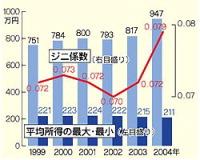地域間格差:所得格差「小泉政権下で拡大」実証 本社集計Extra! Extra!
毎日新聞
99~04年の全国の市区町村の納税者1人あたりの平均所得に関し、格差の度合いを示す「ジニ係数」を年ごとに割り出したところ、02年を境に上昇したことが3日分かった。ジニ係数は毎日新聞が東京大大学院の神野直彦教授(財政学)の協力を得て割り出した。平均所得の最高値と最低値の差は3.40倍から4.49倍に拡大、小泉純一郎前政権の間に地域間格差が開いたことを示した。神野教授は「感覚的に論じられてきたものを初めて定量的に示せた」と指摘しており、地域間格差は4月の統一地方選の主要争点になりそうだ。
Cuts in public works reduces incomes in areas without meaningful industries!
High cost, luxury housing construction in high cost-of-living areas tends to attract high income earners!
Economic recovery tends to favor areas where there is meaningful economic activity!
Where there are few children and most of the adults work, per capita incomes are high!
And Prime Minister Koizumi and his sidekick Takenaka are bad people!
Please.
Less amusing is the graph of the differences in average annual incomes between the highest income municipality, Tokyo's Minato-ku, and the lowest, Akita Prefecture's Higashi Naruse Village.

However idiotic the political rhetoric, the difference in average incomes is stark--frankly, unless one lives in a paid-for home, growing a certain amount of one's vegetables and fruits, 2.11 million yen a year seems an impossibly small amount to live on.
If it were not for the caveat that many of those living in Minato-ku are fulltime workers without children (though from the visual clues the number of couples with children must be growing), I would be seriously concerned about a 5 to 1 ratio in differences in per capita annual incomes.
The government has to come to some decision on how the low-income municipalities are going to cope with the future. The problem is mind bogggling. These areas cannot continue to live parasitically off revenues taken from the core areas. At the same time, without government-derived incomes and new residents--even only temporary ones--these places will become dead zones.
The reemergence of not just relative but real rural poverty in an industrialized nation--the reversal of the arc of 20th century economic development--may be the one truly important story of the present day Japanese economy.
In the print edition (Sunday, February 4) of the article is a graphic of the top ten and bottom ten local administrations (自治体) by income. Tokyo's dominance at the top is no surprise (Minato-ku, Chiyoda-ku and Shibuya-ku are #1, #2 and #3...and Tokyo wards hold 7 of the top 10 places). The real shocker is #4, Okinawa's Ueno Township.
What the heck is in Okinawa's Ueno Township?
At the bottom, unsurprisingly, are a lot of Kyūshū local administrations (two in Miyazaki, two in Kumamoto and one each in Nagasaki and Saga Prefectures), two from perennial population loser Akita (the prefecture with the nation's highest suicide rate) and one each from Hokkaidō and Okinawa Prefectures (balance?).
From time to time I am more than a little sharp about the parasitic prefectures, as if there were something wrong with administrative units unwilling to keel over and just die already. It is hard to get individuals to leave their homes; frequently, the home is one asset a person possesses. We cannot all be happy as little consumers in our manshons on X level of sector N of a single vast, pulsating concrete metropolis.
The culprits here are the politicians. They could push matters in the right direction, any direction, if only they had a little nerve and a little vision. The rural districts are victims of a failure of the imagination at the top, not initiative at the bottom.

1 comment:
MTC:
You are obviously unfamiliar with the makurakotoba=pillow-word tradition in Japanese tanka, the 5-7-5, 7-7 syllable form of poetry, from which haiku eventually evolved. (Long story.) A makurakotoba was a five syllable word (or words) used always in conjunction with another specific word. The makurakotoba itself had no contextual meaning, but sat there, presumably so the poet could save the trouble of making up something meaningful to fill that extra space. Or ease existential angst arising from the reader's encounter with a five-syllable void at (more often than not) the very beginning of the aesthetic experience that he had anticipated. Whatever.
One example:
"tarachine no" haha (since you asked, it means "breast-sagging mother"; literally. Now aren't you sorry you asked, because you just know that this image will come back to haunt you on your deathbed?)
Anyway, "Kiozumi seiken" are the pillow words to kakusa mondai. The media says it out of habit; no one really notices.
BTW, your beloved 4th-place Okinawa village (not township, right?) was subsumed a couple of years ago into the newly created Miyakojima City.
Post a Comment